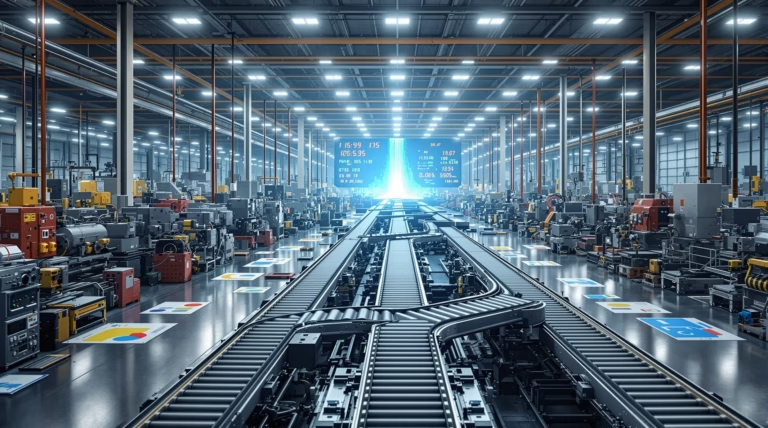Factory Energy Efficiency: Top Strategies for Improved Performance
In today’s rapidly evolving industrial landscape, optimizing factory energy efficiency has become essential for maintaining competitive advantage and meeting sustainability goals. Let’s explore proven strategies and practical approaches that can transform your manufacturing facility’s energy performance while boosting operational excellence.
Understanding Factory Energy Efficiency
Factory energy efficiency represents a cornerstone of modern industrial operations, fundamentally changing how manufacturing facilities approach resource management. In today’s competitive global market, manufacturers must balance production demands with sustainability goals while maintaining profitability. Energy efficiency serves as the critical link that enables this balance, providing a pathway to reduce operational costs while minimizing environmental impact.
Industrial energy management encompasses a systematic approach to identifying, measuring, and implementing energy-saving opportunities throughout manufacturing processes. This holistic strategy extends beyond simple equipment upgrades to include comprehensive system optimization, operational improvements, and technological integration. By embedding sustainability principles into manufacturing operations, companies not only reduce their carbon footprint but also position themselves advantageously against competitors who fail to adapt to increasing energy costs and regulatory requirements.
The Importance of Energy Efficiency in Manufacturing
Energy efficiency stands as a pivotal factor in modern manufacturing success, directly impacting a facility’s bottom line and competitive position. With energy costs representing a significant portion of operational expenses, optimization efforts can yield substantial financial benefits. Beyond cost savings, improved energy efficiency addresses the growing mandate to reduce carbon emissions—a critical consideration as industries face increasing regulatory pressure and consumer demand for sustainable practices.
Manufacturing facilities that prioritize energy efficiency gain resilience against volatile energy markets while simultaneously reducing their environmental impact. The reduction in carbon emissions not only helps meet regulatory requirements but also enhances brand reputation among environmentally conscious customers and partners. Additionally, energy-efficient operations typically experience less equipment downtime, longer machinery lifespans, and improved product quality, creating a virtuous cycle of operational excellence that extends beyond pure energy considerations.
Key Benefits of Improving Energy Efficiency
- Substantial cost savings through reduced energy consumption (10-30% reduction)
- Improved profit margins and freed capital for strategic investments
- Access to tax incentives, rebates, and grants
- Enhanced competitive advantage through lower operational costs
- Improved production reliability and product quality consistency
- Preferred supplier status with environmentally conscious clients
- Access to markets with strict environmental requirements
Top Strategies for Enhancing Factory Energy Efficiency
Manufacturing facilities face mounting pressure to optimize energy usage while maintaining productivity levels. Implementing effective energy efficiency strategies has become essential not only for cost management but also for meeting sustainability targets. Today’s factories can leverage numerous approaches that range from foundational assessment techniques to advanced technological implementations, creating a comprehensive framework for energy optimization.
Conducting Comprehensive Energy Audits
Energy audits serve as the critical first step in any factory efficiency initiative, providing the baseline data needed to make informed decisions. A thorough audit involves detailed examination of all energy-consuming systems, meticulous documentation of usage patterns, and identification of specific inefficiencies throughout the facility. Professional auditors typically employ specialized equipment to measure consumption across different operational scenarios, creating a comprehensive picture of energy flow within the manufacturing environment.
Optimizing HVAC Systems for Energy Savings
| Strategy | Potential Savings |
|---|---|
| Right-sizing equipment | 15-25% |
| Strategic zoning | 10-20% |
| Advanced control systems | 20-30% |
| Regular maintenance | 5-15% |
HVAC systems typically represent 30-40% of total energy usage in manufacturing facilities. Implementation of variable frequency drives (VFDs), programmable thermostats, and regular maintenance routines ensures optimal performance while extending equipment lifespan. These optimization strategies typically deliver 15-30% energy savings with reasonable payback periods, making HVAC improvements one of the most financially attractive efficiency investments.
Implementing LED Lighting Solutions
LED lighting stands as one of the most accessible and impactful energy efficiency upgrades for manufacturing facilities. Modern industrial LED systems deliver remarkable energy savings, consuming up to 75% less electricity than traditional lighting while providing superior illumination quality. The return on investment is particularly compelling, with many facilities achieving complete payback in under two years through reduced utility bills. These advanced fixtures demonstrate exceptional longevity, operating for 50,000-100,000 hours compared to just 10,000-20,000 hours for conventional industrial lighting.
- Minimal heat output reducing HVAC system load
- Intelligent control capabilities including occupancy sensing
- Daylight harvesting functionality
- Programmable scheduling options
- Enhanced productivity through better color rendering
- Reduced glare and more uniform light distribution
- Potential utility incentives and rebates
Advanced Technologies for Energy Management
The industrial sector is experiencing a transformation through sophisticated technologies that revolutionize energy management in manufacturing environments. These advanced systems enable a shift from reactive conservation to proactive optimization strategies. Through digital tools and interconnected systems, manufacturers can now monitor, analyze, and control energy consumption with unprecedented precision, delivering significant reductions in operational costs and environmental impact.
Modern solutions combine hardware sensors, software analytics, and automation capabilities to create comprehensive frameworks addressing energy usage throughout the entire manufacturing process. These systems not only identify inefficiencies but also implement automatic corrective measures, often before facility managers become aware of potential issues. With energy costs representing a substantial portion of manufacturing expenses, these technologies provide measurable returns while supporting broader sustainability goals.
Leveraging Energy Management Systems
Energy Management Systems (EMS) have evolved into sophisticated platforms transforming raw data into actionable intelligence. These comprehensive systems collect information from hundreds of monitoring points throughout manufacturing facilities, creating detailed consumption profiles for individual machines, production lines, and entire facilities. Real-time monitoring enables immediate identification of efficiency deviations, allowing rapid response to energy waste scenarios that might otherwise remain undetected.
| EMS Capability | Business Impact |
|---|---|
| Advanced Analytics | Pattern identification and consumption prediction |
| Intuitive Dashboards | Clear visibility into performance metrics |
| Automated Reporting | Streamlined decision-making processes |
| Real-time Monitoring | Immediate response to efficiency deviations |
Integrating Smart Manufacturing Technologies
Smart manufacturing technologies are revolutionizing factory energy efficiency through seamless integration of industrial Internet of Things (IIoT) devices and intelligent production systems. These create interconnected environments where machines, processes, and energy systems communicate continuously to optimize resource utilization. Embedded sensors throughout production equipment and facility infrastructure provide granular data that reveals previously invisible consumption patterns and optimization opportunities.
- Dynamic energy management adapting to real-time production requirements
- Automated power distribution based on current demands
- Intelligent equipment shutdown during scheduled breaks
- Optimized startup sequences to minimize peak loads
- Predictive maintenance to prevent energy inefficiencies
- Integrated approach to energy and production management
Incorporating Renewable Energy and Waste Heat Recovery
Manufacturing facilities are increasingly adopting dual approaches to energy optimization by integrating renewable energy sources and implementing waste heat recovery systems. This combined strategy creates a comprehensive approach to sustainability, addressing both energy supply and efficiency. As industries face rising energy costs and stricter emissions regulations, these technologies offer practical solutions that deliver both environmental and economic benefits while maintaining operational excellence.
This integrated approach transforms energy management from a necessary expense into a strategic advantage. By capturing and repurposing thermal energy while supplementing needs with renewable sources, factories can dramatically reduce their environmental footprint and achieve substantial cost savings. This strategy strengthens competitiveness in increasingly sustainability-focused markets while ensuring long-term operational resilience.
Benefits of Renewable Energy Integration
Integrating renewable energy sources into manufacturing operations delivers strategic advantages that extend far beyond basic cost reduction. These systems provide crucial protection against energy market volatility while offering predictable costs throughout their multi-decade operational lifespans. The financial benefits are particularly compelling, with many regions offering substantial incentives that can reduce initial costs by 30-50% through:
- Tax incentives and rebates
- Accelerated depreciation benefits
- Improved return on investment calculations
- Long-term energy cost predictability
- Protection against market volatility
The brand value enhancement from renewable adoption creates significant competitive advantages in today’s marketplace. Manufacturers demonstrating tangible sustainability commitments through on-site renewable generation strengthen relationships with environmentally conscious customers, particularly as supply chain sustainability requirements become more stringent. This enhanced brand positioning, combined with reduced operational costs, establishes a compelling business case for renewable integration.
Implementing Waste Heat Recovery Systems
Waste heat recovery represents an often-overlooked opportunity for substantial energy efficiency gains in manufacturing. Through specialized heat exchangers and thermal transfer systems, facilities can capture and repurpose thermal energy that would otherwise dissipate into the environment. These systems enable multiple applications:
- Preheating materials for production processes
- Generating steam for industrial operations
- Powering turbines for electricity generation
- Stabilizing facility temperatures
- Supporting process control optimization
Implementation strategies typically focus on identifying heat sources above 200°F (93°C) that currently vent to the atmosphere. The most effective projects create closed-loop systems targeting continuous heat sources with nearby reuse opportunities, maximizing efficiency while minimizing installation complexity. These systems can reduce overall energy needs by 10-30%, delivering proportional decreases in both utility costs and greenhouse gas emissions.
Building a Culture of Energy Efficiency
Sustainable energy efficiency requires a fundamental organizational mindset shift beyond mere technological solutions. When efficiency becomes embedded in company DNA, it evolves from isolated initiatives into a continuous improvement process driving long-term success. This transformation begins with leadership commitment and extends through all organizational levels, establishing energy conservation as a collective responsibility.
Training Staff on Energy Conservation
Effective energy conservation training transforms employees from passive observers into active efficiency champions. Modern training programs combine traditional classroom education with hands-on workshops, utilizing technology to provide immediate feedback and practical application opportunities. Key training elements include:
- Interactive dashboards displaying real-time consumption data
- Digital simulation tools for risk-free practice
- Role-specific conservation techniques
- Fundamental energy concept education
- Practical workshops for hands-on learning
- Department-specific implementation strategies
Embedding Energy Efficiency as a Core Value
Transforming energy efficiency into a core organizational value requires systematic integration across operations. This process starts with incorporating energy performance into the company’s mission statement and strategic plans. Progressive manufacturers establish clear energy metrics as key performance indicators at every level, from executive dashboards to production floor measurements.
| Recognition Element | Implementation Impact |
|---|---|
| Financial Incentives | Direct rewards for energy savings |
| Public Recognition | Acknowledgment of innovative ideas |
| Team Awards | Collaborative achievement celebration |
| Performance Metrics | Measurable impact tracking |
Collaborative Energy Management Across the Supply Chain
The evolution of factory energy efficiency extends beyond facility walls to encompass the entire supply chain. This holistic approach recognizes that significant optimization opportunities emerge when manufacturers collaborate with suppliers, distributors, and customers. By aligning energy efficiency goals across stakeholders, companies achieve substantial reductions in energy consumption that create a multiplier effect benefiting the entire manufacturing ecosystem.
- Transparent communication frameworks
- Shared performance metrics
- Aligned incentive structures
- Cross-organizational working groups
- Coordinated logistics optimization
- Standardized packaging systems
Optimizing Energy Use Across the Supply Chain
Advanced manufacturers implement interconnected monitoring systems that track energy usage from raw material extraction through manufacturing, distribution, and product use. This end-to-end visibility enables identification of energy hotspots throughout the value chain, prioritizing improvement projects based on potential impact rather than organizational boundaries.
| Collaborative Strategy | Typical Energy Savings |
|---|---|
| Synchronized Production Scheduling | 10-15% reduction in peak demands |
| Coordinated Material Deliveries | 8-12% operational efficiency gain |
| Total Supply Chain Integration | 15-25% overall cost reduction |
The Role of Partnerships in Energy Efficiency
Strategic partnerships accelerate energy efficiency initiatives by providing specialized expertise and resources. These collaborative relationships encompass technology alliances, knowledge-sharing consortiums, and partnerships with energy service companies (ESCOs). The ESCO model particularly stands out, offering turnkey solutions with compensation tied to verified energy savings.
- Technical audit services
- Equipment installation support
- Performance-based financing options
- Continuous monitoring systems
- Utility incentive program access
- Risk-sharing implementation models






